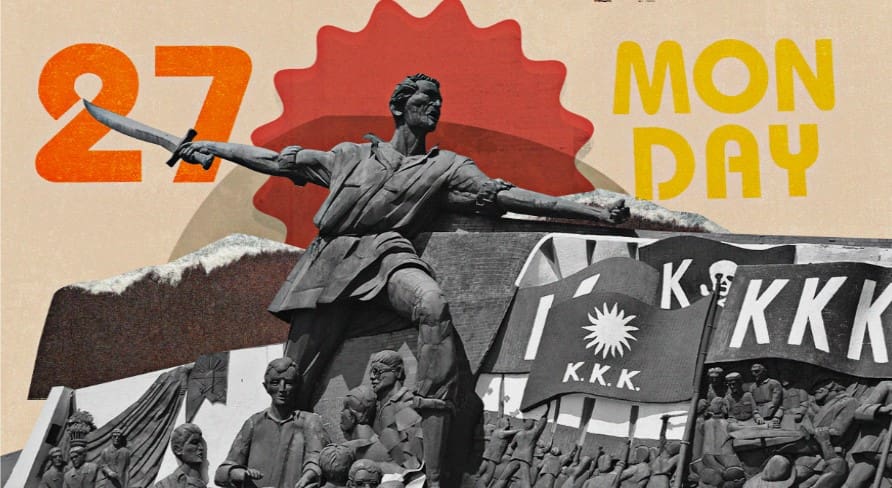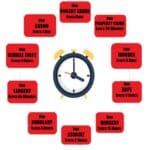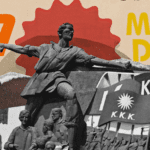Philippines Thanksgiving?

American Thanksgiving was just another Thursday, (November 23), here in Philippines this year; the first time I have not celebrated it in my life, but I have been so busy, eating so well, and life is so good here that I can’t say I missed it. Then, on Sunday I learned that Monday, November 27 was a Philippines Holiday—Bonifacio Day. This day of celebration has a long history recognizing the man who many say was really the first president of Philippines.
Turkey is a Traditional Part of Many USA
Thanksgiving Meals

Exact dates of PH National Holidays are declared at the end of each previous year by the President. Normally held on November 30, Bonifacio Day was moved ahead three days to the 27th for the first time, in 2023, by President Ferdinand Marcos, Jr., to avail Filipinos of a three-day weekend–the Monday nearest the date, while November 30 is a working day this year.
.[1] Bonifacio day Information, 2023
In USA Thanksgiving was originally set on the third Thursday of November; it was changed to the fourth Thursday in 1939 by USA President Franklin Roosevelt in order to lengthen the holiday shopping season.
Bonifacio Day in PH
According to PH website Spot.ph: On November 9, 2022, President Ferdinand R. Marcos, Jr. determined: there is a need to adjust these holidays according to the principle of holiday economics wherein a longer weekend will help encourage domestic travel and increase tourism expenditures in the country.
To encourage domestic travel, not to encourage consumerism!

The True USA Thanksgiving
American kids in public education learn that Thanksgiving was celebrated in New England by the Pilgrims, who were thankful to the Indians for all their help raising food before the winter, so they had a feast and a big party. Elementary school kids draw around their open hands on colored construction paper to create a shape they can add features to–like legs and beaks–and post their turkeys all around the classroom. This is their introduction to what it means to be an American and for many that is as far as it goes for their entire k-12 history-void experience. Social Studies has replaced History as a subject to study in most USA public school curriculums.

But that isn’t the Real Story of Thanksgiving
Anyway
The memoirs of Plymouth governor William Bradford describe the First Thanksgiving as a time of reckoning after two years of failed socialism–when many colonists starved to death. Those who survived had learned through the Law of Natural Consequences some important lessons about human nature and capitalism.

Lessons from A Capitalist Thanksgiving by Jerry Bower:
The members of the Plymouth colony had arrived in the New World with a plan for collective property ownership. Reflecting the current opinion of the aristocratic class in the 1620s, their charter called for farmland to be worked communally and for the harvests to be shared.
Famine came as soon as they ate through their provisions. After famine came plague. Half the colony died. Unlike most socialists, they learned from their mistakes, giving each person a parcel of land to tend to for themselves. The colonists threw off the statist intellectual fashions of their day.
The results were overwhelmingly beneficial. Men worked hard, even though before they had constantly pleaded illness. Fields were not only tilled and planted but also diligently harvested. Colonists traded with the surrounding Indian nation and learned to plant maize, squash and pumpkin and to rotate these crops from year to year. The harvest was bountiful, and new colonists immigrated to the thriving settlement.
[2]Thanksgiving Lessons About the Failures of Socialism and the Success of Private Property and Capitalism, Mark J. Perry, American Enterprise Institute, November 27, 2019
As a proud American I celebrate the good things early settlers did from the time of Christopher Columbus leading to establishment of the freedoms many Americans today take for granted with our Constitution and Bill of Rights.

Revolutionary Supremo President: November 30, 1863– May 10, 1897

Commemoration of the life of Andrés Bonifacio
Andres Bonifacio y de Castro is known as the Father of the Philippine Revolution for leading the revolt against Spanish rule. He founded the Kataastaasan, Kagalanggalangang Katipunan ng mga Anak ng Bayan, commonly called the Katipunan (KKK), a secret revolutionary society which aimed to liberate Philippines from the Spaniards. By 1894, the society and its operations spread throughout Manila, giving women the chance to join the organization as keepers of important documents.
[3]National Museum of the Philippines

The Philstar.com news site reported that a spokesman for President Marcos, Jr. said each Filipino has an important role to play in ensuring the country’s progress.
“Everyone should join activities that will develop our culture, economy and society now that we are striving to achieve a new Philippines,” the President said in a speech delivered by Executive Secretary Lucas Bersamin at the Bonifacio National Monument in Caloocan City.
“Such a heroism can be seen in modern-day heroes – in the diligence and persistence of Filipino workers; in the unmatched skills of nurses and doctors; in the sincere dedication of teachers; in the heroism of police and soldiers; in the unquestionable sacrifice of OFWs (overseas Filipino workers) – all of them give life and meaning to the progress of our nation,” the Chief Executive said.
This is the kind of sentiment we used to get from great USA presidents who loved our country. John F Kennedy famously said: Ask not what your country can do for you, ask what you can do for your country.

Andrés Bonifacio is commemorated on his birthday. National hero José Rizal is remembered on Rizal Day, the date of his death, because Rizal was executed by his fellow countrymen and not at the hands of foreign colonizers.
The content below was originally paywalled.
As the National Hero of Philippines, Jose Rizal was a remarkable man. I have now read quite a lot about why is name is everywhere, from the one-peso coin with his likeness to the main road through Manila. Monuments to Rizal are everywhere and an entire section of the Philippine National Museum is dedicated to this National Hero.
[4]Jose Rizal: PH National Hero for Independence

With onset of the revolution, Bonifacio reorganized the secret Katipunan organization into a revolutionary government, with himself as President (Pangulo) of a nation-state called Haring Bayang Katagalugan (“Sovereign Nation of the Tagalog People” or “Sovereign Tagalog Nation”). “Tagalog” referred to all those born in the Philippine islands and not merely the Tagalog speaking regions. Hence, some historians have argued that he should be considered the First President of the Tagalogs instead of the Philippines; that is why he is not included in the current official line of succession.
[5] Guererro, Milagros; Encarnacion, Emmanuel; Villegas, Ramon (1996). “Andres Bonifacio and the 1896 Revolution”. Sulyap Kultura. National Commission for Culture and the Arts. 1 (2): 3–12. Archived from the original on April 2, 2015. Retrieved December 7, 2008.
On August 30, 1896, Bonifacio personally led an attack on San Juan del Monte to capture the town’s powder magazine and water station (which supplied Manila). The defending Spaniards, outnumbered, fought a delaying battle until reinforcements arrived. Once reinforced, the Spaniards drove Bonifacio’s forces back with heavy casualties. Bonifacio and his troops regrouped near Mariquina (now Marikina), San Mateo and Montalban (now Rodriguez). Elsewhere, fighting between rebels and Spanish forces occurred in San Felipe Neri (now Mandaluyong), Sampaloc, Santa Ana, Pandacan, Pateros, Mariquina, Caloocan, San Pedro Macati (now Makati) and Taguig. The conventional view among Filipino historians is that the planned general Katipunan offensive on Manila was aborted in favor of Bonifacio’s attack on San Juan del Monte, which sparked a general state of rebellion in the area. However, more recent studies have advanced the view that the planned offensive did push through and the rebel attacks were integrated; according to this view, Bonifacio’s San Juan del Monte battle was only a part of a bigger whole – an unrecognized “Battle for Manila”. Despite his reverses, Bonifacio was not completely defeated and was still considered a threat. Further, the revolt had spread to the surrounding provinces by the end of August.
Bonifacio as PH National Hero
Bonifacio was executed by Major Lazaro Macapagal under the order of the Consejo dela Guerra (Council of War) headed by General Mariano Noriel in 1897 on the basis of committing sedition and treason against the government. He is a national hero today because he had to pay the ultimate price when the situation was fluid and he stood his ground.

Mariano Noriel (c. 1864 – January 27, 1915) fought during the Philippine Revolution and the Philippine–American War. He was member of the War Council that handled the case of Andres Bonifacio in 1897. He led Filipino advance troops before the American army landed in Intramuros in 1898.
Bonifacio brothers Andres and Procopio were tried by the War Council in Naik and later in Maragondon in May 1897. Convicted of sedition and treason, Andres and Procopio were sentenced to death but General Emilio Aguinaldo, president of the newly established Revolutionary Government, commuted the death verdict to banishment to the Pico de Loro Mountain in Maragondon. The commutation, however, was later withdrawn due to strong pressure from senior army officers and prominent citizens, including General Pio del Pilar and Noriel himself. They believed that the two brothers, if allowed to live, would endanger the revolution.
Withdrawal of the commutation order was construed by Noriel, who was also in charge of the prisoners, as a go signal for the execution of the sentence, and so he had the two brothers shot to death by a squad of soldiers under Major Lazaro Macapagal on May 10, 1897.
Aguinaldo, in the book A Second Look at America, which he co-authored with Vicente Albano Pacis, claims that his withdrawal of the commutation order did not mean immediate implementation of the death verdict, that Noriel had misconstrued this and acted hastily. He says he wanted a little more time for a cooling-off period so that eventually the Bonifacio brothers would be forgiven and pardoned.

Had Bonifacio not been executed he likely wouldn’t have become a national hero.
Payback for Noriel
After the revolution Gen. Noriel, along with two others, were sentenced to death for the murder of a man in the Bacoor cockpit in May 1909. The PH Court of First Instance decision on the case was later confirmed by the Philippine Supreme Court.
A do-gooder Irish-American lawyer named Amzi B. Kelly appealed the Philippine verdict to the Supreme Court of the United States, which subsequently reversed the decision. But before the final verdict was received from Washington, Noriel and his co-accused had already been executed by hanging in Manila on January 27, 1915.
Noriel is not a national hero, but Bonifacio whom he had executed is. This pre-winter holiday is a great time to consider what matters in our lives.
References:
[1]Bonifacio day Information, 2023
https://www.spot.ph/newsfeatures/policy/107031/november-27-bonifacio-day-based-on-proclamation-no-90-a833-20231108
[2]Thanksgiving Lessons About the Failures of Socialism and the Success of Private Property and Capitalism, Mark J. Perry, American Enterprise Institute, November 27, 2019 https://www.aei.org/carpe-diem/thanksgiving-lessons-about-the-failures-of-socialism-and-the-success-of-private-property-and-capitalism/
[3]National Museum of the Philippines
https://www.nationalmuseum.gov.ph/2021/11/30/bonifacio-day-onthisday-feature/
[4]Jose Rizal: PH National Hero for Independence
https://donnliston907.substack.com/p/alaska-philippine-connection-2
[5]Guererro, Milagros; Encarnacion, Emmanuel; Villegas, Ramon (1996). “Andres Bonifacio and the 1896 Revolution”. Sulyap Kultura. National Commission for Culture and the Arts. 1 (2): 3–12. Archived from the original on April 2, 2015. Retrieved December 7, 2008.





